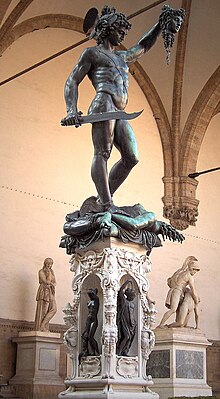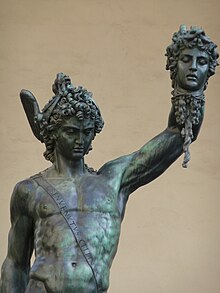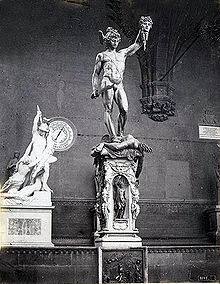Perseus (Benvenuto Cellini)
The Perseus , in the literature Perseus with the Medusa or Perseus with the head of Medusa , is a bronze sculpture in Florence . It was created by Benvenuto Cellini in the middle of the 16th century and is considered to be his main work. It is one of the most famous sculptures of the Italian Renaissance . The technically difficult casting of the main character in one piece is considered a masterpiece of that time. It was created for the front of the left of the three arcades of the Loggia dei Lanzi , where it is still located.
The motive and the order
The figure of Perseus is shown . According to Greek mythology , he killed Medusa , the most terrible of the three sisters of the Gorgons . Before that, he had received a cloak of invisibility, wing shoes and a magic bag from the nymphs , the titan's weapon , the sickle sword, from Hermes , and a mirrored bronze shield from Athena . To the events after his arrival near the gardens of the Hesperides it says in the Metamorphoses of Ovid (Book IV, Chapter 12):
- Thereupon he reached the Gorgons' dwelling through very remote, pathless gaps, staring from the desert forests, and saw stone images of people and wild animals everywhere in the fields and along the paths, which were transformed from living beings into hard rock by the sight of Medusa were. However, he himself only saw the form of the terrible Medusa in the reflective ore of the shield that he was holding with his left and, while deep sleep held the snakes and herself, separated her head from her torso.
Cellini received the commission to depict this scene from Duke Cosimo I of Medici in July 1545. At the time, Cellini was actually doing goldsmithing at the court of King Francis I of France in Fontainebleau and returned to Florence to visit his impoverished sister support. Cosimo met Cellini in the ducal villa in Poggio a Caiano and placed the order there. Cellini saw in this the possibility of not only working as a goldsmith, but also of competing with Donatello or Michelangelo as a sculptor . Cellini's view may have tipped the balance that “only monumental sculptures ensure the artist's fame”. The French king was not at all pleased with this decision, Cellini was summoned twice to Paris to give an account, but did not comply with these demands. He received his own house and workshop from Cosimo and lived there from 1545 until his death. There has been a commemorative plaque there since the 19th century with an explicit mention of the cast of Perseus.
Cosimo's intentions for the commission were of a political nature: On the one hand, the subjects of Perseus and Hercules were always popular forms of depicting the rulers of princely houses, and on the other, Cosimo saw himself as Perseus. The work was ultimately intended to be a demonstration of the power of the ducal family to the Florentine citizens. It should be demonstrated that Cosimo had freed Florence from its enemies like Perseus had freed Andromeda depicted in the lower relief .
Preparatory work and casting
The work up to the unveiling dragged on from 1545 to 1554. Cellini first submitted a wax design to the Duke , which was approved. However, he modified this design slightly over the course of time, and it is occasionally seen as more successful than the current version. Cellini also enlarged the originally planned height of 3.20 meters including the base to the current height. It was clear to him that the sculpture would have to compete with the famous large-scale sculptures and sculptures in the loggia, such as the Judith by Donatello , installed in 1494, the David by Michelangelo from 1504 and the group of Hercules and Cacus by Baccio Bandinelli , installed in 1512. The design by Perseus was an alternative to Donatellos Judith. Both works deal with the subject of beheading , the execution as a bronze figure on a marble plinth and the reduction to two figures are comparable.
The history of the creation of the sculpture and the explanation for the long delays occupy a large space in Cellini's autobiography. He saw the main culprit in his arch rival Bandinelli, who is said to have made difficulties for him out of jealousy in obtaining the material and the necessary auxiliary staff. Cellini also suffered from kidney disease at times. In addition to his main job, he also carried out minor goldsmithing work for the ducal house. The entire work consists of several parts: the four smaller figures of the base, the relief plate with the Andromeda group below the base and the figure of the beheaded Medusa with Perseus standing on it. The first part cast was the figure of the crooked Medusa in the summer of 1548.
Cellini made use of the lost wax technique . He first formed a clay core, on which he modeled the intricacies with wax, with metal pins holding the work together, and surrounded the clay core with plaster of paris. The whole thing was heated from below so that the wax flowed out. He poured the bronze alloy into the resulting cavity. After cooling, he knocked off the plaster, removed the pins and the clay core, and completed the figures.
The cast of the main character took place in December 1549 and was extremely dramatic. Even before that, the Duke had repeatedly doubted that the casting would succeed with the alloy proposed by Cellini. It can also be read that he dispatched soldiers to arrest Cellini immediately if the casting failed. After the wax had melted and the block was moved into the casting pit, the workshop caught fire when it was heated up, while on the other side rain was pouring in due to a storm. Difficulties arose when melting the metal itself because the part that had already melted curdled. Cellini then added another sixty pounds of tin to the alloy in order to liquefy it again. Immediately afterwards, the lid of the furnace burst, whereupon Cellini immediately opened the mouth of the mold (today's chopped off Medusa head) and opened the casting holes so as not to lose the metal. As he did so, he noticed that it wasn't going into shape fast enough. In order to liquefy it further, since there was no more tin in the workshop, he had his own tin plates and bowls, about 200 pieces according to him, put into the alloy. The next day he and his guests therefore had to eat lunch made from pottery. Cellini allowed the figure to cool for two days and then began exposing the cast. Except for a small spot on his right foot, Cellini already knew that it could not be completely poured. completely successful. Cellini went with the news to the Duke, who was in Pisa , and at the same time requested leave in Rome , which was granted to him. After the four small statues for the base and the relief plate had been cast, the figure was unveiled on the morning of April 17, 1554.
The representation
Perseus stands on the naked, hunched, and decapitated corpse of Medusa. The figure is shown with a slight counterost , the hips turned slightly to the left. The left free leg stands on the body, the right leg on the brazen shield of Athena. Perseus holds the severed head with his left arm, raised upright, while the right one carries the sickle sword of Hermes. The direction in which the tip of the sword points, towards the front, towards the viewer, is no coincidence, but belongs to the concept of the Medici demonstration of power against the Florentine citizens. Cellini designed all the other parts mentioned in mythology; the magic sack is under the body of Medusa, the magic shoes are indicated by Hermes wings on the feet.
Perseus is depicted at the moment he shows the head of the crowd. The precise representation of the muscular body reveals precise and lengthy anatomical studies. Cellini managed to combine movement through posture and calm in the midst of a dramatic event. The figure is the only work signed by Cellini; his name is on a ribbon running across Perseus' chest.
Base, small bronzes and relief plate
The implementation of Cellini's artistic principle can be seen in the design of the pedestal : mindfulness . Cellini had already requested in a letter to Benedetto Varchi in 1549 that a free-standing figure must have eight sides; as a goldsmith, he had already implemented this concept when creating the famous salt barrel for Francis I of France on the base. Consequently, the edges of the square base are not straight and smooth, but richly decorated.
The four smaller bronze sculptures in the niches are Danaë with Perseus, Jupiter , Mercury and Minerva . In combination with the figure, they form an indication of the different ages of the man: the little Perseus stands for childhood, Mercury for the young man, the large figure of Perseus for the young man, Jupiter for the adult man and the Janus mask on the back of Perseus' head for the old man. The Duchess liked the four small bronzes so much that after Cellini had brought them to her, she wanted to include them in her own collection and was not ready to return them. Cellini then had the figures secretly removed from their rooms and attached to the plinth, which caused considerable annoyance to the Duchess. This approach may have been one of the reasons that Cellini never again received a major commission from the ducal family after Perseus. The base and small bronzes have meanwhile been replaced by copies. The originals are in the Museo nazionale del Bargello .
The relief plate below the base was made at the express request of the duke. It depicts the liberation of Andromeda by Perseus, again with the political statement that the Duke (Perseus) freed the city of Florence (Andromeda) from the hands of their enemies.
Follow-up and reception
After the figure was completed, a dispute arose between Cellini and Cosimo I over the fee. Cellini asked for 10,000 Florentine guilders , which the Duke was not prepared to pay. Only a referee called by Cellini, it was the Florentine commander Hieronymus Albizzi , succeeded in settling the dispute. Cellini received only 3,500 guilders and was extremely dissatisfied with it.
When it was unveiled, the sculpture aroused great enthusiasm and high praise, which was expressed in numerous hymns of praise attached to it in the form of sonnets , some of which have survived. Colleagues such as Agnolo Bronzino showered Cellini with praise, and the duke accepted him into the Florentine nobility that same year.
In the assessment of later centuries, the figure does not come off quite as well. It was criticized that one would look too much at her goldsmith because the figure "fell into petty detail" when treated individually. In a similar opinion, the figure lacks generosity.
The more recent research deals, among other things, with sociological aspects of the figure, for example feminist questions.
Another question is to what extent Cellini's sculpture lends itself as a motif that glorifies violence. A drawing (probably from the beginning of the 20th century), which emphasizes the muscular strength and victory pose of Perseus, is used by the Polish organization Zadruga for a poster with which they advertise their nationalist goals.
literature
swell
- Benvenuto Cellini: Treatises on the goldsmith's art and sculpture . translated by Justus Brinckmann, edition (reprinted unchanged) by Ilmer, Osnabrück 1978.
- Benvenuto Cellini: My life . The autobiography of a Renaissance artist, translated by Jaques Langer, Manesse Verlag, Zurich.
Secondary literature
- Reinhard Abenstein: Greek mythology. UTB series, Ferdinand Schöningh, Paderborn 2005, ISBN 978-3-506-71720-7 .
- Baroni, Falugi, Novarese u. a .: Florence and its art treasures. Edizioni Storti, Venice 1977.
- Wolfgang Braunfels : Small Italian Art History . DuMont Buchverlag, Cologne 1984, ISBN 3-7701-1509-0 .
- James Cleugh: The Medici - Splendor and Power of a European Family. 2nd edition, Deutscher Taschenbuch Verlag, Munich 1985, ISBN 3-423-10318-3 .
- Margaret A. Gallucci, Paolo L. Rossi: Benvenuto Cellini, scupltor, goldsmith, writer , Cambridge University Press, Cambridge 2004 ISBN 0-521-81661-0 .
- Andreas Grote: Florence - shape and history of a community. 5th edition, Prestel Verlag, Munich 1980, ISBN 3-7913-0511-5
- Fritz Knapp : High Renaissance, Baroque and Rococo. Vol. II of the series The artistic culture of the West , 2nd to 3rd ed., Kurt Schroeder, Bonn / Leipzig 1923.
- Edgar Lein, Manfred Wundram: Mannerism . Volume 7 of the series Art Epochs. Philipp Reclam jun., Stuttgart 2008, ISBN 978-3-15-018174-4 .
- Andreas Prater: Cellini's salt barrel for Franz. I .: Table-top device as a symbol of rule. Steiner Verlag, Wiesbaden 1988, ISBN 3-515-05245-3 .
- Loretta Santini: Florence, the cradle of Italian art. Nova Lux, Giusti di Becocci, Florence 1973.
- Max Semrau: The Art of the Renaissance in Italy and in the North. 3rd edition, Vol. III from Wilhelm Lübke, Grundriss der Kunstgeschichte. 14th edition, Paul Neff Verlag, Esslingen 1912.
- Rolf Toman (Ed.): The art of the Italian Renaissance - architecture, sculpture, painting, drawing. Tandem Verlag, Cologne 2007, ISBN 978-3-8331-4582-7 .
- Stefano Zuffi: The Renaissance - Art, Architecture, History, Masterpieces. DuMont Buchverlag, Cologne 2008, ISBN 978-3-8321-9113-9 .
Web links
Individual evidence
- ^ A b Edgar Lein, Manfred Wundram: Mannerism. P. 76.
- ↑ a b c Zuffi: The Renaissance - Art, Architecture, History, Masterpieces , p. 323
- ↑ Abenstein: Greek Mythology , p. 137
- ^ Ovid: Metamorphosen , newly translated and edited by Gerhard Fink , Artemis Verlag, Zurich and Munich 1989, p. 109
- ↑ a b Cellini: Mein Leben , p. 688
- ↑ Wolfgang Braunfels : Small Italian Art History , p. 385
- ↑ Cellini: Mein Leben , p. 689
- ↑ Prater: Cellini's salt barrel for Franz. I .: Table-top device as a symbol of rule , p. 10
- ↑ a b c Cellini: Treatises on goldsmithing and sculpture , p. 32.
- ↑ a b Grote: Florence - shape and history of a community. P. 328.
- ↑ a b c Braunfels: Little Italian art history. P. 386.
- ↑ a b c Toman (ed.): The art of the Italian Renaissance - architecture, sculpture, painting, drawing , p. 236.
- ↑ Santini: Florence, The Cradle of Italian Art , p. 28
- ↑ Toman (Ed.): The art of the Italian Renaissance - architecture, sculpture, painting, drawing , p. 232
- ↑ Grote, Florenz - Shape and History of a Community , p. 329
- ↑ Cellini: Treatises on goldsmithing and sculpture , p. 33
- ↑ Baroni, Falugi, Novarese et al. a .: Florence and its art treasures , p. 13.
- ↑ Cellini: Mein Leben , p. 404
- ^ A b c d Cellini: Treatises on the goldsmith's art and sculpture. P. 35.
- ↑ Cellini: My life . P. 407.
- ↑ a b Cellini: Mein Leben , p. 408.
- ↑ Cellini: My life . P. 689.
- ^ Zuffi: The Renaissance - Art, Architecture, History, Masterpieces . P. 328.
- ↑ Lein and Manfred Wundram: Mannerism . P. 77.
- ↑ Prater: Cellini's salt barrel for Franz. I .: Table-top device as a symbol of rule . P. 54f.
- ^ Gallucci, Paolo L. Rossi: Benvenuto Cellini, scupltor, goldsmith, writer , p. 142.
- ^ A. Gallucci, Paolo L. Rossi: Benvenuto Cellini, scupltor, goldsmith, writer . P. 145.
- ↑ a b Cellini: Treatises on goldsmithing and sculpture. P. 37.
- ↑ Cellini: My life . P. 437.
- ↑ Semrau: The Art of the Renaissance in Italy and in the North . P. 263.
- ↑ Knapp: High Renaissance, Baroque and Rococo . P. 112.
- ^ A. Gallucci, Paolo L. Rossi: Benvenuto Cellini, scupltor, goldsmith, writer , p. 142 ff.
- ↑ ? Retrieved December 30, 2018 (Polish).





